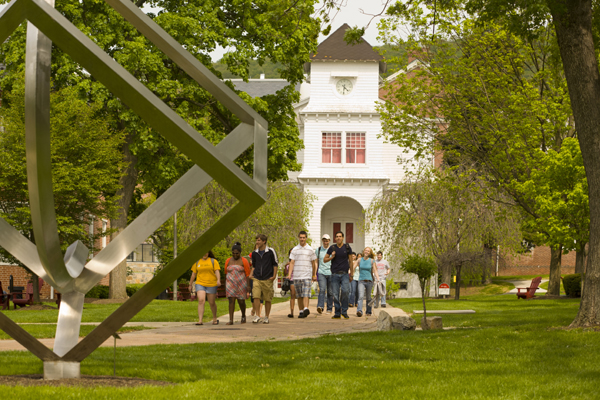Reading, Pa. – In one scenario, participants ride a creepy elevator to an unknown destination. In another, they enter the swirling world of color and light that is Vincent van Gogh’s masterpiece “The Night Café.”
With a pair of goggles and a couple of computers, Albright College’s virtual reality lab is helping students research various disorders – from epileptic seizures to color blindness to concussions – as well as how people respond to stressful situations, and the impact of certain therapeutic techniques, including art therapy.
“It has been very effective in simulating stressful situations so that we can explore how people respond to fear and discomfort without actually having to put them in danger,” said associate professor of psychology Justin J. Couchman, Ph.D.
Couchman, who researches self-agency – or the feeling that we control our own actions – started the virtual reality lab a couple of years ago to explore this field further. But he quickly realized “there are an almost endless variety of research questions you could explore with our setup.”
This summer, rising senior Renee Hunsberger, a psychobiology major from Pottstown, is using the stressful elevator simulation to study the effect of self-efficacy (our belief in our own capability) on physiological stress appraisal (how our bodies automatically respond to stress, such as increased heart rate and perspiration).
Before donning the goggles, Hunsberger’s participants recall either a moment in their lives when they successfully overcame a difficult task (self-efficacy increase), or a time when they failed to do so (self-efficacy decrease). During the simulation, participants are wired to another computer that measures their physiological responses to various stimuli in the elevator ride. Hunsberger hypothesizes that the self-efficacy increase group will better cope physically with the stress of the elevator ride because they first recalled a confidence-boosting moment.
“Looking at the effects of self-efficacy on stress appraisal, I hope to provide insight into easy and effective tools that would help college students better manage the everyday stress in their lives,” said Hunsberger, whose work is part of the Albright Creative Research Experience program.
To date, Albright students have also used the VR lab to simulate the effects of color blindness and to research concussions by exposing participants to stressful or relaxing conditions to see how that impacted memory and other processes related to the head injuries.
Albright graduate Natalie Wilson ’17 employed the virtual van Gogh painting to measure the biological and psychological effects of exposure to art, while her classmate Gwenievere Birster ’17 used VR to simulate the visual effects associated with partial epileptic seizures. Both presented their research at the International Convention of Psychological Science in Vienna, Austria, this past spring.
“Our research would not have been possible without the use of virtual reality. Having the VR lab at Albright in general allows students to develop state-of-the-art research that, at many other universities, isn’t possible at an undergraduate level,” said Birster, who is now a clinical research assistant in the Anxiety and Stress Disorder Lab at the Massachusetts-based McLean Hospital, an affiliate of Harvard Medical School.
Albright’s VR lab is not confined to psychology-based research. The technology can be used in a variety of fields, including architecture, medicine, video game design and business.
“So students interested in almost any area can get hands-on experience with cutting-edge technology and ask questions they’re interested in answering,” said Couchman.




